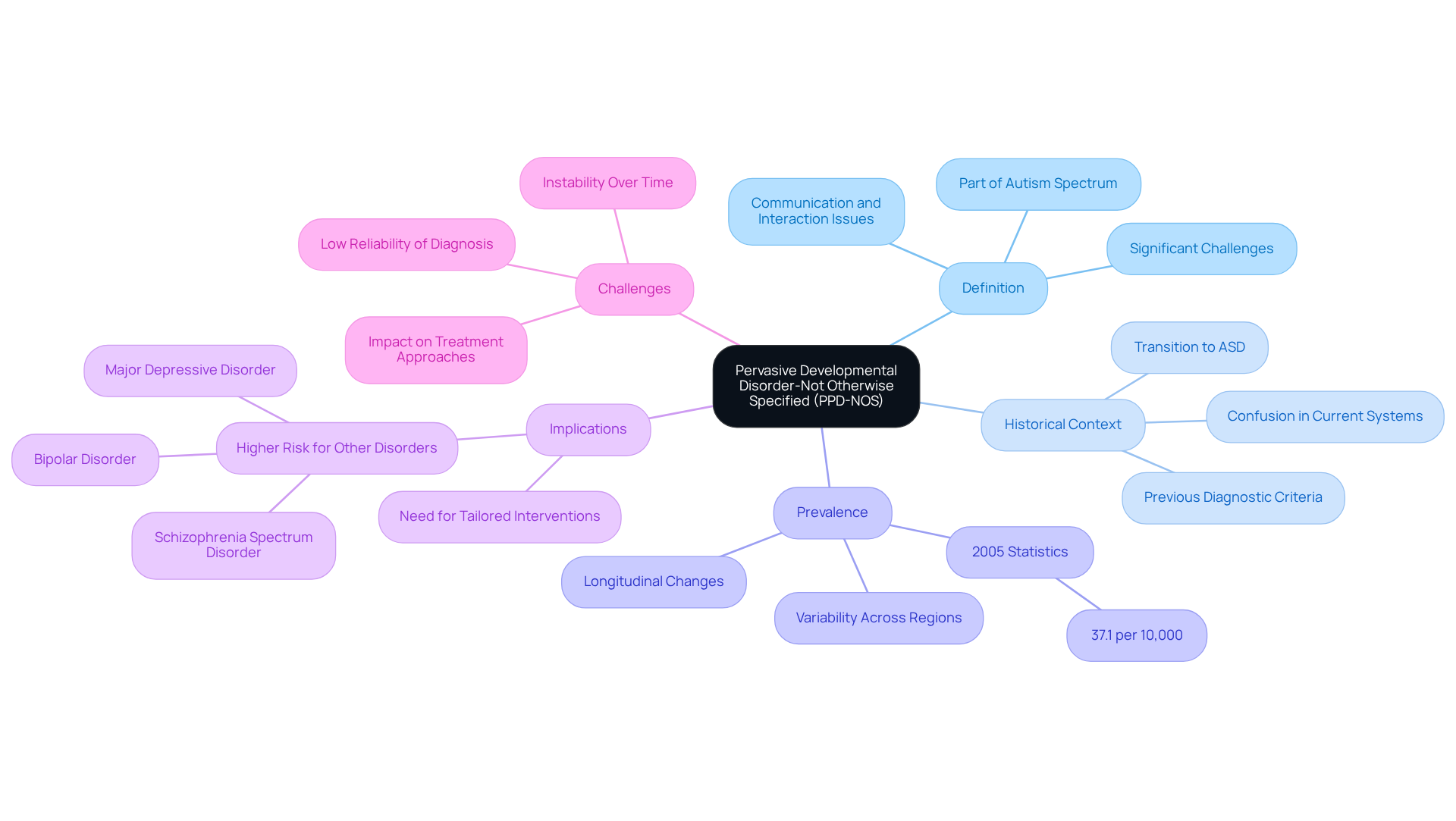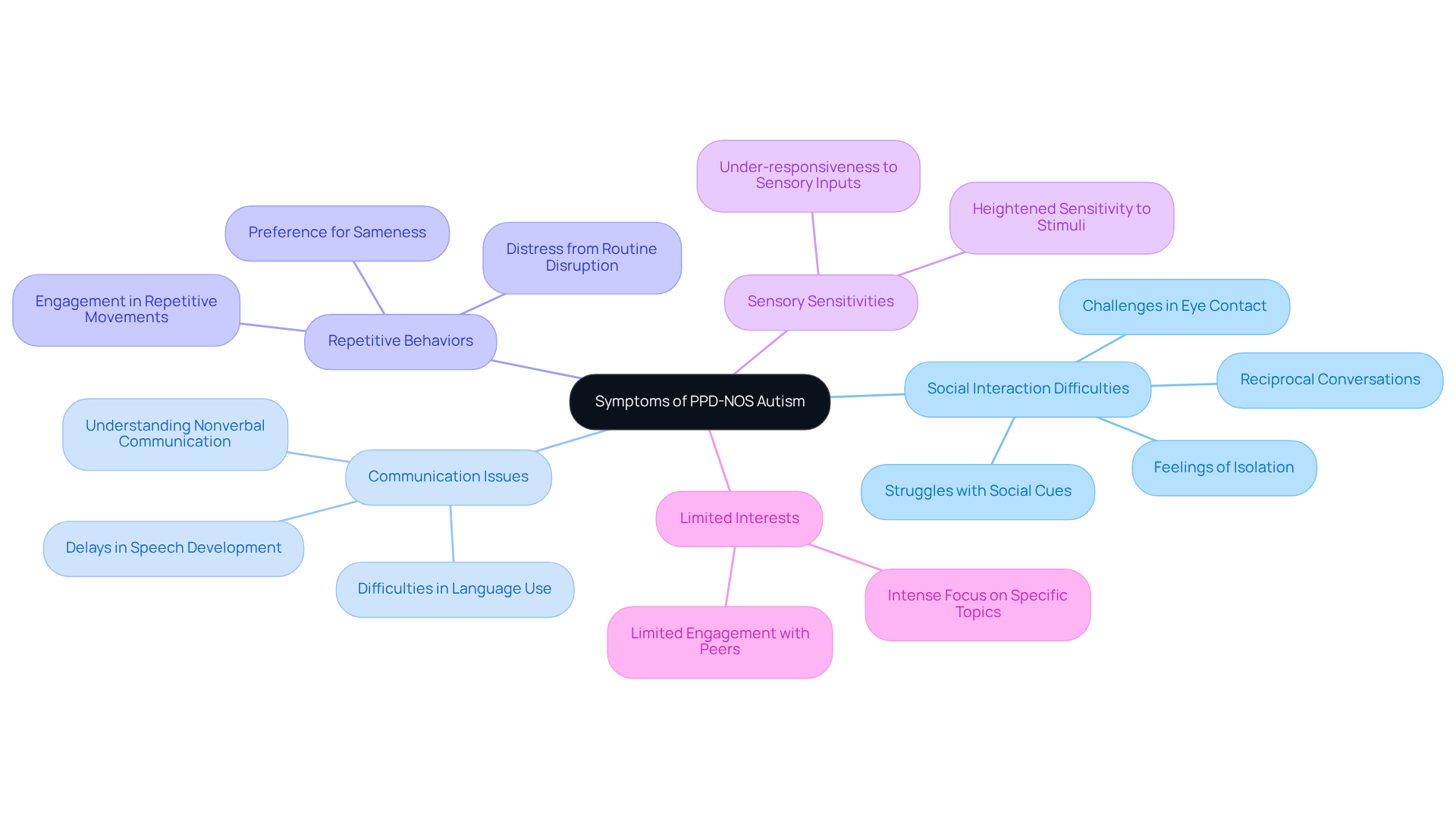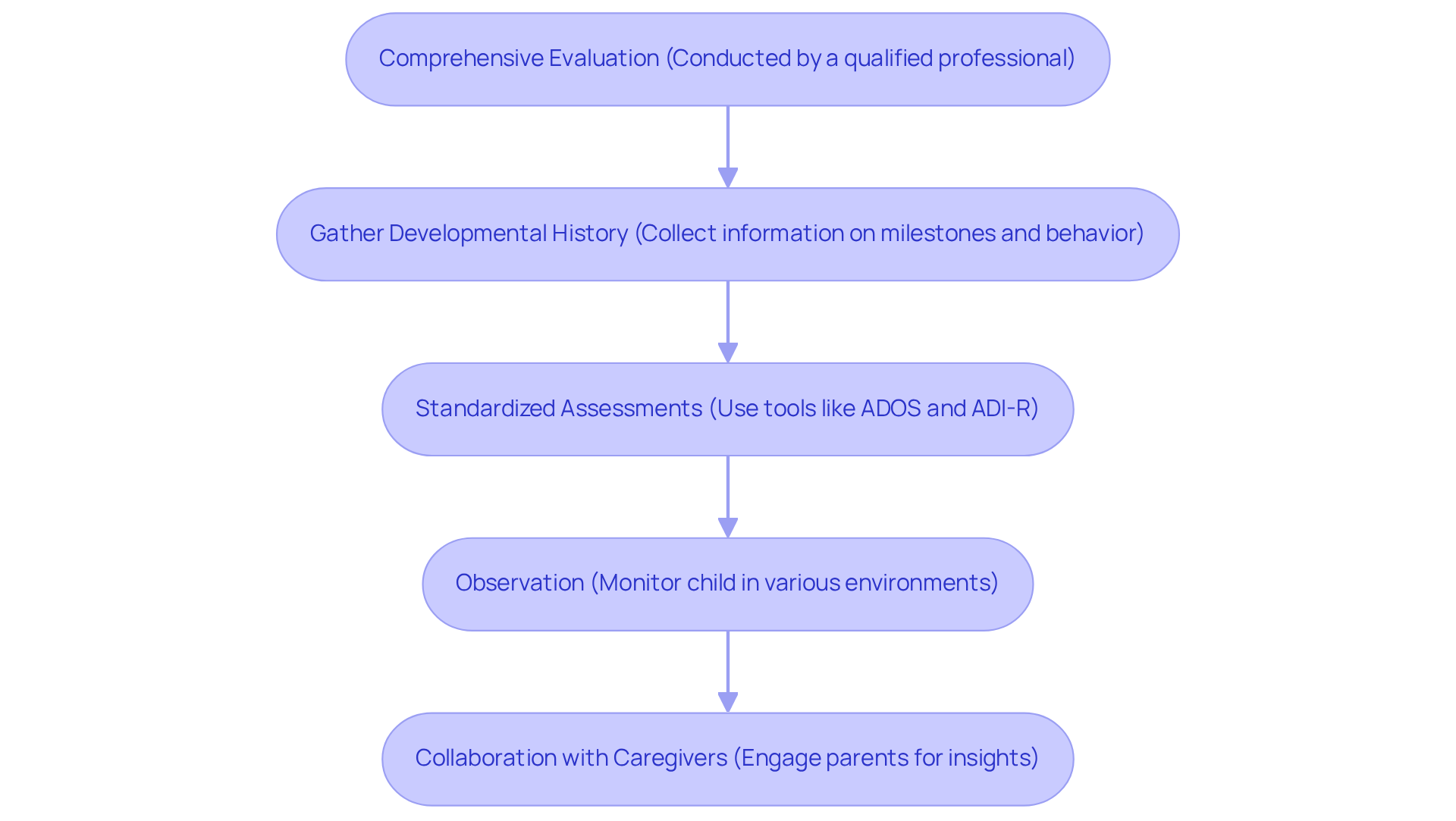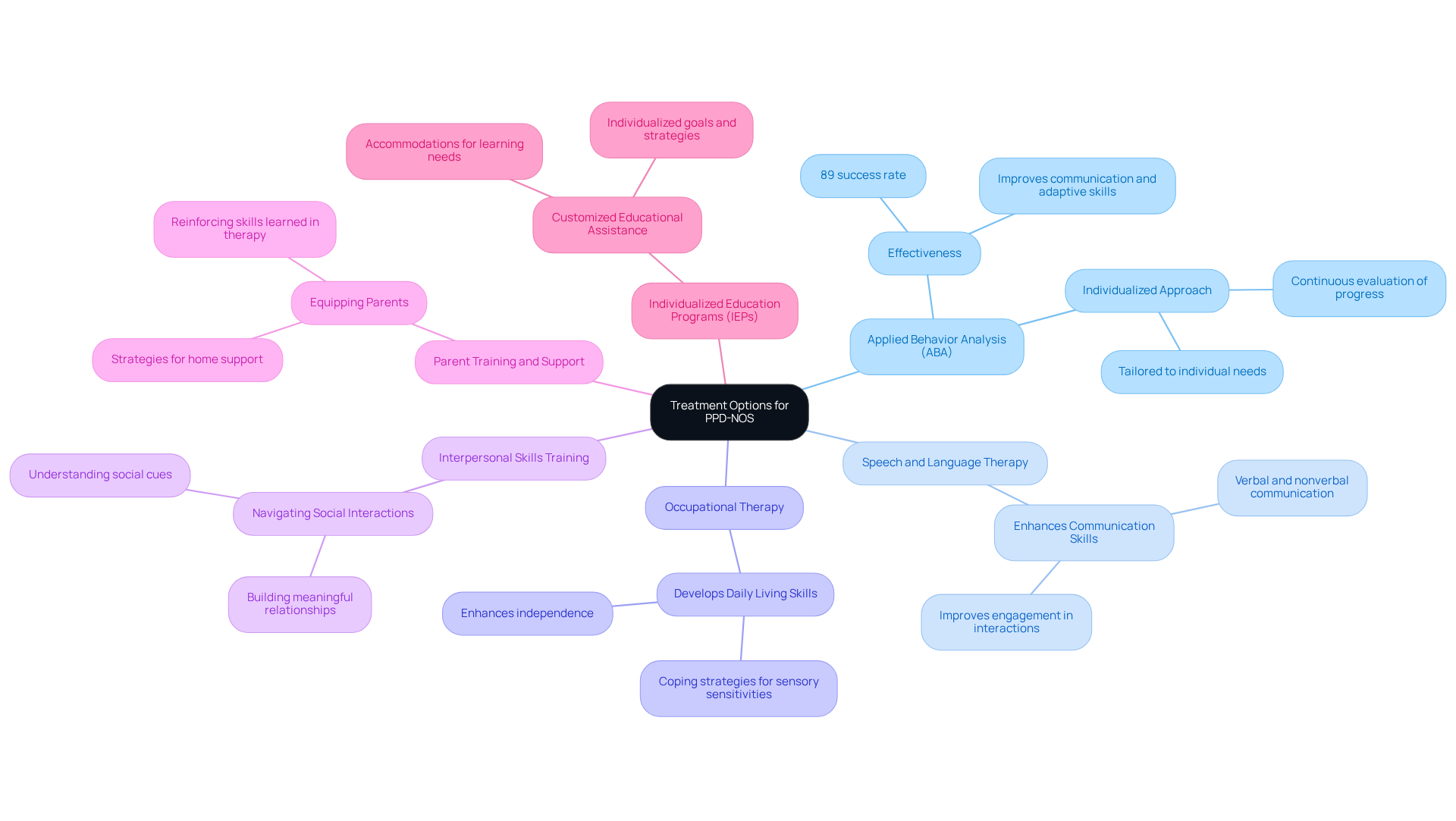Overview
Pervasive Developmental Disorder-Not Otherwise Specified (PPD-NOS) autism presents unique challenges in social interaction and communication that may not fully align with the criteria for other autism spectrum disorders. Understanding PPD-NOS is crucial, especially when considering its historical context, prevalence, symptoms, diagnostic processes, and tailored treatment options. This knowledge not only sheds light on the complexities of the condition but also highlights the support strategies that can make a meaningful difference for those affected.
For parents, the journey with PPD-NOS can feel overwhelming. It’s essential to recognize that you are not alone in this experience. Many families face similar hurdles, and sharing stories can foster a sense of community and understanding. By exploring the symptoms and diagnostic processes, we can better appreciate the nuances of PPD-NOS, paving the way for effective support and intervention.
As we delve into the available treatment options, let’s remember that each child is unique, and what works for one may not work for another. Tailored approaches can significantly enhance the quality of life for individuals with PPD-NOS. We invite you to engage with us—share your experiences, ask questions, and seek guidance. Together, we can navigate this journey with compassion and understanding.
Introduction
Pervasive Developmental Disorder-Not Otherwise Specified (PPD-NOS) is a complex aspect of autism spectrum disorders that has historically presented challenges in both diagnosis and understanding. As our medical community continues to evolve, so does the need for clarity regarding this condition, especially with its recent classification under the broader Autism Spectrum Disorder (ASD) umbrella. This article aims to shed light on the symptoms, diagnostic processes, and treatment options associated with PPD-NOS, offering valuable insights for families and professionals alike.
Navigating the intricacies of PPD-NOS can feel overwhelming. Many families share similar concerns and experiences, and it’s essential to ensure effective support for those affected. How can we come together to foster understanding and compassion in this journey? Join us as we explore the facets of PPD-NOS and discover ways to provide the support that is so crucial for families facing these challenges.
Define Pervasive Developmental Disorder-Not Otherwise Specified (PPD-NOS)
Pervasive Developmental Disorder-Not Specified (PPD-NOS autism) is a diagnosis historically used to describe individuals who experience significant challenges in interaction and communication but do not fully meet the criteria for other specific autism spectrum disorders (ASD). This condition is marked by a variety of developmental delays, particularly in social skills and communication abilities. Previously recognized as PPD-NOS, this diagnosis was part of the broader classification of pervasive developmental disorders, which includes autism and Asperger's syndrome. Although the DSM-5 has now replaced this diagnosis with the overarching term Autism Spectrum Disorder (ASD), it is crucial to understand PPD-NOS autism to recognize the diverse challenges related to autism that individuals may face.
Recent statistics reveal that the prevalence of PPD-NOS autism was about 37.1 per 10,000 in 2005, accounting for a significant portion of autism diagnoses before the revision of diagnostic criteria. Notably, research has shown that 39% of children identified with atypical developmental disorders around the age of two no longer met the ASD criteria by age four. This underscores the importance of ongoing evaluation and tailored interventions. Additionally, the variability in prevalence rates across different populations highlights the need for a nuanced understanding of this condition.
As Maurizio Elia points out, the elimination of this diagnosis from current diagnostic systems has led to confusion, emphasizing the importance of clarity in understanding this category. It is also essential to recognize the limitations of PPD-NOS, including its low reliability and instability over time, which can impact diagnostic accuracy and treatment approaches. By fostering awareness and understanding, we can better support individuals and families navigating these complexities.

Identify Symptoms and Characteristics of PPD-NOS
Symptoms of ppd nos autism can manifest in various ways, often leading to significant challenges in daily life. Understanding these symptoms is crucial for parents navigating this journey. Here are some key characteristics to consider:
- Social Interaction Difficulties: Individuals may struggle to interpret social cues, maintain eye contact, and engage in reciprocal conversations. These challenges can hinder their ability to form meaningful relationships, leaving them feeling isolated.
- Communication Issues: Noticeable delays in speech development may occur, along with difficulties in using language for social interaction. Understanding both verbal and nonverbal communication can be particularly challenging, adding to their frustration.
- Repetitive Behaviors: A tendency to engage in repetitive movements or routines is common. Many individuals exhibit a strong preference for sameness and experience distress when their routines are disrupted, which can be difficult for families to manage.
- Sensory Sensitivities: Abnormal responses to sensory stimuli are often present. This may include heightened sensitivity or under-responsiveness to sounds, lights, textures, or tastes, affecting comfort and behavior in various environments.
- Limited Interests: Individuals may focus intensely on specific topics or activities, often showing little interest in other areas. This can limit their engagement with peers and broader experiences, making social interactions more challenging.
Identifying these symptoms promptly is vital, particularly in the context of ppd nos autism, as it can lead to timely interventions and support strategies that greatly enhance outcomes for those affected. According to a CDC study, 1 in 8 women experience symptoms of postpartum depression, highlighting the prevalence of these challenges. As Kylie Jenner wisely advises, "stay inside that moment, even if it is painful," emphasizing the importance of acknowledging these feelings.
Real-life experiences, such as those shared by Tia Mowry, who sought support from her family and friends, illustrate the significance of having a support system. By fostering a community where individuals can share their experiences, ASD Media aims to empower parents and professionals to navigate these challenges effectively. We encourage you to connect with others, share your stories, and seek support—together, we can create a nurturing environment for everyone affected.

Understand the Diagnostic Process for PPD-NOS
Navigating the diagnostic process for PPD NOS autism can feel overwhelming for many families. Understanding the steps involved can help provide clarity and reassurance during this critical time.
A comprehensive evaluation is the foundation of this process. A qualified healthcare professional, such as a psychologist or psychiatrist who specializes in developmental disorders, conducts a thorough assessment. This assessment is essential for grasping the unique needs of your child, ensuring that they receive the support they deserve.
Gathering a developmental history is also vital. Detailed information about your child's developmental milestones, behavior patterns, and family history is collected. This context is crucial for interpreting symptoms and understanding their impact on your child's life.
Standardized assessments, such as the Autism Diagnostic Observation Schedule (ADOS) and the Autism Diagnostic Interview-Revised (ADI-R), are employed to evaluate social communication and behavior. These tools provide objective data that aids in diagnosis, giving you a clearer picture of your child's strengths and challenges.
Observation plays a key role as well. Professionals monitor your child in various environments, such as home and school, to evaluate interactions and behaviors in real-life situations. This observational data is vital for understanding how your child functions in different settings.
Collaboration with caregivers is another important component. Engaging parents and caregivers provides insights into the child's behavior and development, significantly contributing to a comprehensive understanding of their needs.
By combining these elements, professionals can reach a precise diagnosis and identify the most effective support strategies. It's important to note that the average age of diagnosis for autism spectrum disorders is around 5 years, particularly for conditions like PPD NOS autism, while the average age of first intervention in the U.S. is 4.7 years. This highlights the significance of early intervention and thorough assessments to enhance outcomes for young individuals.
Additionally, about 1 in 6 (17%) children aged 3-17 years were diagnosed with a developmental disability during the study period of 2009-2017. This statistic underscores the importance of caregiver insights in the diagnostic process. Furthermore, disparities in diagnosis and intervention ages based on income levels can impact developmental outcomes, making it crucial to address these challenges together. Lastly, it's noteworthy that ASD is over 3 times more prevalent among boys than girls, which is essential for understanding the demographics of those diagnosed with related conditions.
As you navigate this journey, remember that you are not alone. Seeking support and sharing experiences can make a significant difference in your child's development and your family's well-being.

Explore Treatment Options and Support Strategies for PPD-NOS
Treatment options for PPD-NOS are thoughtfully tailored to meet the unique needs of each individual, and they may include:
- Applied Behavior Analysis (ABA): This widely recognized approach focuses on enhancing specific behaviors through reinforcement strategies and structured interventions. Research indicates that ABA therapy has shown significant effectiveness in improving communication abilities, interpersonal skills, and adaptive behaviors in individuals with autism, specifically those with PPD NOS autism. In fact, studies have demonstrated an impressive over 89% success rate in treating autism spectrum disorder among young individuals.
- Speech and Language Therapy: Targeted support is provided to enhance communication skills, encompassing both verbal and nonverbal communication. Research has shown that children undergoing speech therapy often notice remarkable improvements in their ability to communicate and engage in interactions.
- Occupational Therapy: This therapy assists individuals in developing daily living skills and coping strategies to manage sensory sensitivities, ultimately enhancing their interactions with others. Occupational therapy plays a crucial role in fostering independence and improving quality of life.
- Interpersonal Skills Training: Programs designed to teach individuals how to navigate interactions, understand cues, and build meaningful relationships are vital. These training sessions empower individuals with ppd nos autism to develop the skills necessary for successful social engagements.
- Parent Training and Support: Equipping parents with strategies to support their children's development at home fosters a collaborative approach to care. Parental involvement is essential for reinforcing skills learned in therapy and ensuring consistency in the child's environment. As ASD Media emphasizes, parental support is crucial for the continuation of therapy.
- Individualized Education Programs (IEPs): For school-aged children, IEPs provide customized educational assistance to meet specific learning needs. These programs ensure that young individuals receive the necessary accommodations and resources to thrive academically. IEPs specifically support children with ppd nos autism by outlining individualized goals and strategies that cater to their unique learning requirements.
By implementing these strategies, families can create a nurturing environment that promotes growth and development for individuals with ppd nos autism.

Conclusion
Pervasive Developmental Disorder-Not Otherwise Specified (PPD-NOS) represents a complex aspect of the autism spectrum, marked by significant challenges in social interaction and communication. Even though current diagnostic manuals have transitioned to the broader category of Autism Spectrum Disorder (ASD), understanding PPD-NOS remains essential for recognizing the diverse experiences of those affected by this condition.
This article explores the various symptoms associated with PPD-NOS. These include:
- Difficulties in social interaction
- Communication issues
- Repetitive behaviors
- Sensory sensitivities
- Limited interests
It also outlines the diagnostic process, highlighting the importance of comprehensive evaluations and collaboration with caregivers to ensure accurate diagnoses and effective intervention strategies. Furthermore, the discussion on treatment options underscores the significance of tailored approaches—such as Applied Behavior Analysis, speech and language therapy, and individualized education programs—which can greatly enhance outcomes for individuals with PPD-NOS.
Ultimately, fostering awareness and understanding of PPD-NOS is crucial for supporting affected individuals and their families. By encouraging open dialogue, sharing experiences, and promoting access to resources, communities can create a nurturing environment that empowers those navigating the challenges of autism. The journey may be complex, but through collective efforts, we can achieve meaningful progress and improve the quality of life for individuals with PPD-NOS.
Frequently Asked Questions
What is Pervasive Developmental Disorder-Not Otherwise Specified (PPD-NOS)?
PPD-NOS is a diagnosis used to describe individuals who face significant challenges in interaction and communication but do not fully meet the criteria for other specific autism spectrum disorders (ASD). It is characterized by various developmental delays, particularly in social skills and communication abilities.
How has the classification of PPD-NOS changed over time?
The DSM-5 has replaced the PPD-NOS diagnosis with the broader term Autism Spectrum Disorder (ASD), but understanding PPD-NOS remains important to recognize the diverse challenges individuals with autism may face.
What were the prevalence rates of PPD-NOS autism?
In 2005, the prevalence of PPD-NOS autism was approximately 37.1 per 10,000, representing a significant portion of autism diagnoses before the revision of diagnostic criteria.
What does research indicate about children diagnosed with atypical developmental disorders?
Research has shown that 39% of children identified with atypical developmental disorders around the age of two no longer met the ASD criteria by age four, highlighting the importance of ongoing evaluation and tailored interventions.
What are some limitations of the PPD-NOS diagnosis?
The PPD-NOS diagnosis has low reliability and instability over time, which can affect diagnostic accuracy and treatment approaches.
Why is it important to understand PPD-NOS despite its removal from current diagnostic systems?
Understanding PPD-NOS is crucial to support individuals and families navigating the complexities of autism, as its elimination has led to confusion about the challenges associated with autism spectrum disorders.




